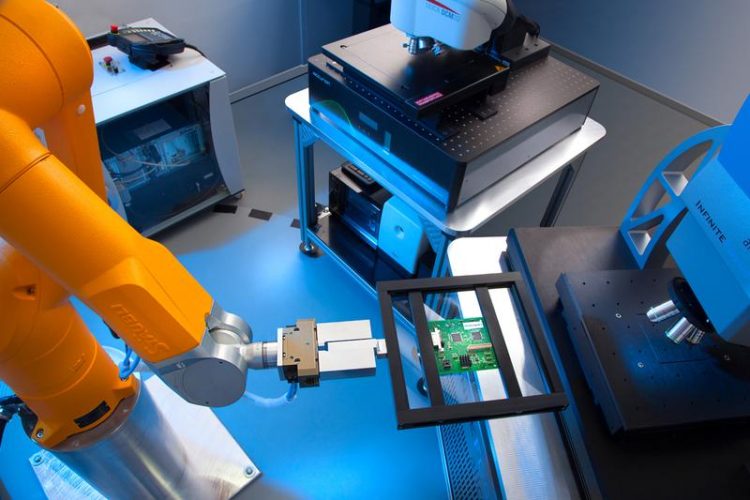CeBIT: Automated microscopy in the MicroLab

In MicroLab a robot handles the sample on the microscopes. Photo: Manfred Zentsch © Fraunhofer IOSB 2013
Microelectronics is one of the most important industries of our high-tech world. More and more products are equipped with computer technology. Used mainly in computers only a few years ago, processors can today be found in medical systems, watches, glasses, smart textiles, vehicles, and in building automation systems. The entertainment and communication technology is booming in our interconnected world. Meanwhile, microelectronics have arrived at the nanoscale, the components being so tiny that a processor fits into the size of a pinhead. This places high demands on production.
Fraunhofer IOSB has long been concerned with automated image analysis for quality assurance in production, and especially with the inspection of surfaces. The idea was born of transferring this knowledge to the world of microscope imaging. A demonstration and test environment was developed for fully automated inspection with various microscopes, which were combined using established automation components. In MicroLab a range of optical microscopes are available as examples. Currently they include a macroscope with flexible lighting options, a white-light/confocal microscope, a research microscope, and a 3D-reconstructing autofocus system.
Robot as operator
The microscopes are operated by a standard six-axis industrial robot, which places the samples under the microscopes precisely in a defined position. Project manager Peter Frühberger explains: “The robot is connected to a central control unit, which can access additional sensors. The inspection system therefore remains informed about the current process and can intelligently steer the inspection sequence. Test sequences are distributed over the microscopes, so that, wherever possible, all systems can be used simultaneously.” This saves time and yields results that are optimized for the respective inspection task.
Modular design
MicroLab is deliberately composed of standard automation technology components. This permits its use as a complete system for inspection, analysis, and quality assurance for a wide range of objects and surfaces. The range of available microscopes ensures that a wide range of tasks can be solved. The combined use of several microscopes, furthermore, opens new possibilities in applications for which individual microscopes would not suffice. Because of its modular design, selected components of MicroLab could easily be incorporated in existing systems.
Another advantage of MicroLab is that industry customers can test various microscopes in their application to determine which is best suited and how to best integrate it into the existing installation.
MicroLab also benefits from the extensive experience of IOSB in the field of image processing. Established methods from the fields of image fusion and photometric stereo imaging have been transferred to the microscopic dimension.
The adaptation of such proven practices pays a significant contribution to successfully putting modular and industry-capable microscopic inspection systems into industrial use.
At CeBIT 2014, part of MicroLab will be presented to the public for the first time. It can be seen in Hall 9 at the Fraunhofer stand.
Media Contact
All latest news from the category: Trade Fair News
Newest articles

Silicon Carbide Innovation Alliance to drive industrial-scale semiconductor work
Known for its ability to withstand extreme environments and high voltages, silicon carbide (SiC) is a semiconducting material made up of silicon and carbon atoms arranged into crystals that is…

New SPECT/CT technique shows impressive biomarker identification
…offers increased access for prostate cancer patients. A novel SPECT/CT acquisition method can accurately detect radiopharmaceutical biodistribution in a convenient manner for prostate cancer patients, opening the door for more…

How 3D printers can give robots a soft touch
Soft skin coverings and touch sensors have emerged as a promising feature for robots that are both safer and more intuitive for human interaction, but they are expensive and difficult…





















